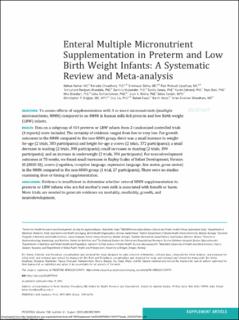| dc.contributor.author | Kumar, Mohan | |
| dc.contributor.author | Chowdhury, Ranadip | |
| dc.contributor.author | Sinha, Bireshwar | |
| dc.contributor.author | Upadhyay, Ravi Prakash | |
| dc.contributor.author | Chandola, Temsunaro Rongsen | |
| dc.contributor.author | Mazumder, Sarmila | |
| dc.contributor.author | Taneja, Sunita | |
| dc.contributor.author | Edmond, Karen | |
| dc.contributor.author | Bahl, Rajiv | |
| dc.contributor.author | Bhandari, Nita | |
| dc.contributor.author | Ramakrishnan, Usha | |
| dc.contributor.author | Rivera, Juan A. | |
| dc.contributor.author | Tandon, Sonia | |
| dc.contributor.author | Duggan, Christopher P. | |
| dc.contributor.author | Liu, Enju | |
| dc.contributor.author | Fawzi, Wafaie | |
| dc.contributor.author | Manji, Karim | |
| dc.contributor.author | Choudhary, Tarun Shankar | |
| dc.date.accessioned | 2023-04-17T13:03:17Z | |
| dc.date.available | 2023-04-17T13:03:17Z | |
| dc.date.created | 2022-10-24T11:56:48Z | |
| dc.date.issued | 2022 | |
| dc.identifier.issn | 0031-4005 | |
| dc.identifier.uri | https://hdl.handle.net/11250/3063380 | |
| dc.description.abstract | OBJECTIVES
To assess effects of supplementation with 3 or more micronutrients (multiple micronutrients; MMN) compared to no MMN in human milk-fed preterm and low birth weight (LBW) infants.
RESULTS
Data on a subgroup of 414 preterm or LBW infants from 2 randomized controlled trials (4 reports) were included. The certainty of evidence ranged from low to very low. For growth outcomes in the MMN compared to the non-MMN group, there was a small increase in weight-for-age (2 trials, 383 participants) and height-for-age z-scores (2 trials, 372 participants); a small decrease in wasting (2 trials, 398 participants); small increases in stunting (2 trials, 399 participants); and an increase in underweight (2 trials, 396 participants). For neurodevelopment outcomes at 78 weeks, we found small increases in Bayley Scales of Infant Development, Version III (BISD-III), scores (cognition, receptive language, expressive language, fine motor, gross motor) in the MMN compared to the non-MMN group (1 trial, 27 participants). There were no studies examining dose or timing of supplementation.
CONCLUSIONS
Evidence is insufficient to determine whether enteral MMN supplementation to preterm or LBW infants who are fed mother's own milk is associated with benefit or harm. More trials are needed to generate evidence on mortality, morbidity, growth, and neurodevelopment. | en_US |
| dc.language.iso | eng | en_US |
| dc.publisher | AAP | en_US |
| dc.rights | Navngivelse 4.0 Internasjonal | * |
| dc.rights.uri | http://creativecommons.org/licenses/by/4.0/deed.no | * |
| dc.title | Enteral Multiple Micronutrient Supplementation in Preterm and Low Birth Weight Infants: A Systematic Review and Meta-analysis | en_US |
| dc.type | Journal article | en_US |
| dc.type | Peer reviewed | en_US |
| dc.description.version | publishedVersion | en_US |
| dc.source.articlenumber | e2022057092N | en_US |
| cristin.ispublished | true | |
| cristin.fulltext | original | |
| cristin.qualitycode | 2 | |
| dc.identifier.doi | 10.1542/peds.2022-057092N | |
| dc.identifier.cristin | 2064319 | |
| dc.source.journal | Pediatrics | en_US |
| dc.relation.project | Norges forskningsråd: 223269 | en_US |
| dc.identifier.citation | Pediatrics. 2022, 150 (Supplement 1), e2022057092N. | en_US |
| dc.source.volume | 150 | en_US |
| dc.source.issue | Supplement 1 | en_US |

